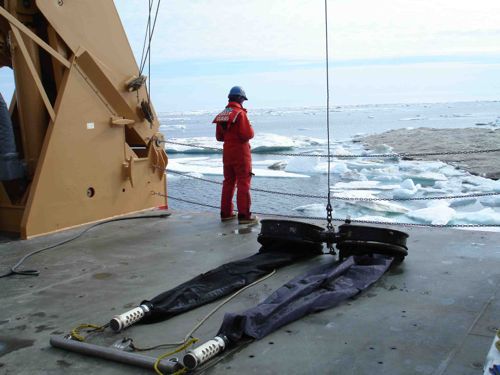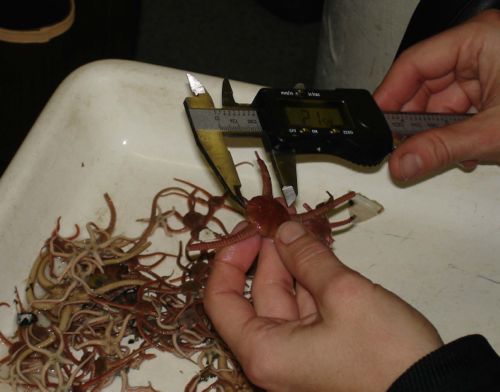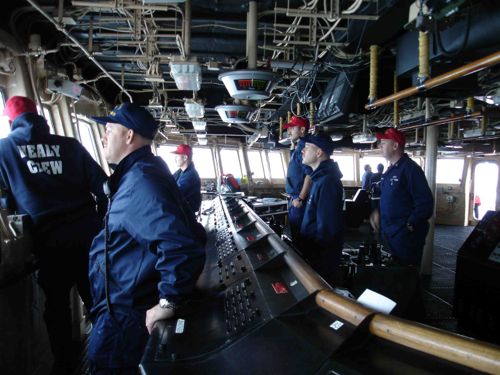Join the Polar research team as we use technology to join Dr. Carin Ashjian this summer as she continues her research in the Arctic! I will be posting Dr. Ashjians journal details of this summer's research expeditions. We first catch up with her onboard the icebreaker U.S.C.G.C. Healy and then will follow her onboard the R/V Anika Marie where she and her team members will continue their Barrow-based research studying the oceanographic conditions of the bowhead whale habitat.
Journal EntryI tilted my head forward. A stream of water poured off the brim of my hardhat, onto the waterproof notebook in which I was recording the time, latitude, and longitude of our net tow. It was raining. Persistently. There were puddles on the deck from the rain, not from our hoses with which we wash the nets. Everyone’s Mustang suits became deeper orange in color as the rain saturated the fabric. We net haulers are in the business of wet, between the nets themselves and the hosing down of the nets, but this was just too much. Isn’t this supposed to be the Arctic?


We have now sampled at 58 stations on Hanna Shoal. Time is running out for our cruise and the push is on to try to expand our geographic range while at the same time hitting critical and important locations. Everyone clamors to sample at his or her favorite spot. The plan has to balance time and the programmatic, and individual scientist’s, needs. So far we think that we can do it before we have to break off and sail to Barrow.
For the last couple of days we had been working to the eastern side of the study area and across Barrow Canyon. Here the sea ice had disappeared, melted or been blown away, so that we were working in open water. The wind was brisk, blowing from the NE and opposing the prevalent current (the Alaska Coastal Current) that runs to the NE through Barrow Canyon. Some waves had built up and even the 420’ Healy was experiencing some slight motion. At several locations in the Canyon we were able to capture the elusive krill, or euphausiids, which are important prey for the bowhead whales that migrate past Barrow in spring and fall of each year. Despite our efforts, krill are sparse on Hanna Shoal. Our success in Barrow Canyon demonstrates that we CAN catch krill, if they are present.
Today we were working near some ice floes and decided to launch the two small boats so that scientists could collect ice algae and sea ice. First, the Healy had to break a path through the ice so that the interior portion would be exposed so the small boats could collect the fresh algae. The floe chosen was thicker than most we had been working near. The ship gathered speed and crunched through the ice, slowing as she moved forward until finally she stopped….paused….and then slid backwards…then backed to re-ram the ice and complete the break in. This was like ice breaking in spring, rather than late summer where the ice simply bumps away most of the time. After the ice had been broken, the small boats were launched and the scientists were off to collect ice algae while the rest of us continued on with our regular sampling back on the ship.

We have been in fog or rain for several days and the viewing conditions for marine mammal and bird observations have not been particularly good. However, today we did see a dead walrus on an ice floe. Examination, albeit from a distance, revealed that the walrus had apparently been the dinner of a polar bear. No polar bear was present when we visited but the glaucous gulls were enjoying the feed.
Today was Saturday and dinner was cooked by the chiefs (not chefs) (a different group on board takes turns cooking on every Saturday night. Usually science takes a turn but this cruise is too short to do so). The chiefs did a great job of making breakfast for dinner, including home made donuts. This evening was a showing of the newest Star Trek movie on the big screen in the helo hanger, complete with popcorn.

*PolarTREC Journal written by research scientist Dr. Carin Ashjian. Journal and photos posted by Springs School PolarTREC Educator Lisa Seff.


Comments